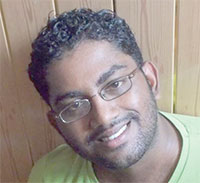“A QUIET Place” offers us to a rare innovative horror movie, swarming with monsters and full of heart. Strange monsters, fast and deadly, roam a rural area in the US. The monsters are blind and hunt by sound, using their complex system of hearing to pick up the smallest of sounds. The family at the centre of the story uses sign-language to communicate and, therefore, manage to survive longer than many others.
Yet, despite all of these references to sound, sound itself is not the most terrifying aspect of “A Quiet Place.” Silence, the lack of sound for broad stretches of time, and the horror – alive and throbbing with hunger – that exists in that silence are the elements that are used to create the moments of sublime tension that are found at several crucial junctions throughout the film. It is alarming that so many of us have now recognised the power of silence so late in the timeline of cinema, but, perhaps, this should not be surprising, because if darkness is to sight, then silence is definitely to hearing, and, at our core, we’re all scared of the dark, aren’t we?
There have been countless horror films that have used silence (in conjunction with sound) to give us many memorable scares throughout the years. Think of the pause before the jump-scare sound that plays before the ghost emerges, or the silence that circles the heroine in the forest just before we hear the growl of the monster. These are moments in which silence is used to create fear, and they are techniques that have been used in countless movies. What sets “A Quiet Place” from other horror movies is its extensive use of silence as the major device, and without relegating it to the secondary position as a mere helper to the device of sound. In “A Quiet Place”, silence stands on its own and is a force that exists and operates as powerfully as the explosion of a meteor or the roar of a dragon.
Apart from its excellent use of silence, the film does use sound to a lesser degree, exploiting it to ramp up tension and to create the chilly, dark atmosphere that was required for the film.
Undoubtedly, the best thing about the movie, apart from its creativity with silence and sound, is the cast of the four actors who form the family unity.
Noah Jupe plays the youngest child of the family and he is an actor so expressive that he brings to mind a young Dakota Fanning, imparting much with his eyes and appearing to be so engrossed in whatever he is acting out that it is sometimes possible to forget that what is flashing on the screen is only fiction and he is not actually a little boy trying to escape monsters and save his family, while being unable to make a single sound. He is a remarkable child.
Equally good is Millicent Simmonds, a deaf actress who plays the rebellious teenage daughter in the family. Simmonds does her part well, bringing a level of emotion, angst and guilt to her performance. She is a part of some of the film’s most terrifying outdoor sequences, including a horrifying scene in which she is sucked into a mountain of grain, which was as scary as any of the monsters of the film.
Simmonds in playing this character – a well-developed, well thought out character who feels and expresses her feelings despite the double-barrier of having to communicate her feelings through her own deafness, as well as the soundlessness imposed on her as everyone tries to survive the monsters is a victory for differently-abled people, and indeed, it is difficult to remember the last time such representation was made onscreen. The mere presence of Simmonds and her strong performance is a reminder that those who are different do have skills that must be utilised and dreams that must be fulfilled.
John Krasinski, as the director of “A Quiet Place”, was pulling double duty by casting himself in the lead role, and yet he never faltered in either position. His role was that of the head and protector of the family – a part that could have been icy and distant from the other characters had Krasinski not imparted a kind of humanity within the character that came out so strongly that you could almost see the beating heart within the man, flaming with love for his family, or the cogs ticking in his brain as he constantly tried to work out what needed to be done in order to ensure their continued survival. The heartbreaking scene in the film’s climax that takes place between him and his daughter is one of the best parts of the movie, despite it being a moment that emphasised the theme of family, which, strangely, managed to run concurrently with the horror theme without clashing, and rather, complementing it.
Emily Blunt as the mother and wife, pregnant and full of joy, warmth and humour – despite not being able to express any of it using her voice, gives the best performance in the film. There is a scene involving her and a nail and that made the audience gasp, flinch and scream in rapid succession. It was one of the best shot scenes in the movie, alternating between the threat of the monsters, Emily Blunt’s character, and utilising the audience’s knowledge of the nail stuck upright in the stair. Placing bets on the idea that every audience member thoroughly checked the next stair they encountered after seeing this movie might actually be quite rewarding.
The moment when the characters begins to deliver her baby in the bathtub, as she lies there, bloody, crippled, and her hands clamped over her mouth as she tries to stifle the screams of pain that come with childbirth, all while one of the monsters is right next to her might be one of the scariest, jaw-dropping sequences ever witnessed in a horror film. To paraphrase one movie-goer:
“That scene gave me anxiety!” Blunt’s performance, as a tear-streaked, blood-streaked mother, barely breathing so as to not make a sound, trying to keep her newborn silent so as to not make a sound, and trying to locate her husband and her other children without making a sound will go down as one of her best performances. It is quite one thing for an actress to scream and shout and throw things as a way of expressing how her character feels. It is a more arduous, and more fascinating task, to express pain, love, grief and fear in total silence, using only body and expression instead of voice.
All in all, “A Quiet Place”, is a remarkable film, bolstered by an interesting concept, an interesting cast, a mind-blowing performance from Emily Blunt, and some of the best scares to reach the Guyanese audience in recent years.



.jpg)








